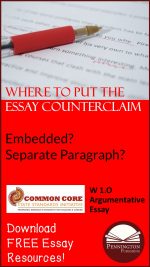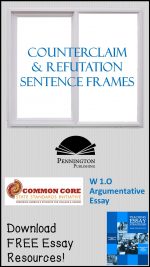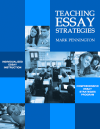
Where to Put the Essay Counterclaim
Where is the best place to put the essay counterclaim? The short and sweet answer? David Oldham, professor at Shoreline Community College, states, “The short answer is a counter-argument (counterclaim) can go anywhere except the conclusion. This is because there has to be a rebuttal paragraph after the counter-argument, so if the counter-argument is in the conclusion, something has been left out.”
The counterclaim is the opposing point of view to one’s thesis and is also known as the counterargument. The counterclaim is always accompanied by a refutation, sometimes referred to as a rebuttal. The Common Core State Standards include the counterclaim in Writing Standards 1.0 for grades 7-12. These Standards reference the organization of the counterclaim in terms of clear relationships and logical sequencing. See the boldface phrases in the following grades 7-12 Standards.

Common Core State Standards
Seventh Grade: Introduce claim(s), acknowledge alternate or opposing claims, and organize the reasons and evidence logically.
Eighth Grade: Introduce claim(s), acknowledge and distinguish the claim(s) from alternate or opposing claims, and organize the reasons and evidence logically.
Ninth and Tenth Grade: Introduce precise claim(s), distinguish the claim(s) from alternate or opposing claims, and create an organization that establishes clear relationships among claim(s), counterclaims, reasons, and evidence.
Eleventh and Twelfth Grade: Introduce precise, knowledgeable claim(s), establish the significance of the claim(s), distinguish the claim(s) from alternate or opposing claims, and create an organization that logically sequences claim(s), counterclaims, reasons, and evidence.
Placement Options
1. Writers can place a separate counterclaim paragraph with refutation as the last body paragraph prior to the conclusion paragraph.
Separate Paragraph Example #1
COUNTERCLAIM Opponents argue that after school sports can increase the likelihood of sports-related injuries. Specifically, health professionals suggest that life-threatening concussions occur at frightening rates for student athletes participating in such popular after school sports as football, soccer, basketball, and wrestling (Bancroft 22, 23). Even minor injuries sustained from participation in after school sports increase absent rates and the expense of creating injury reports for students (Sizemore 3). REFUTATION Although students do suffer both serious and minor injuries in after school sports, these injuries are quite rare. The organization, supervision, and safety measures of school-sponsored sports are superior to those of alternative fee-based community-sponsored recreational leagues or even privately sponsored sports organizations (Kinney 2). Additionally, without free after school sports programs, many students would still play sports without adult supervision and even more injuries would result.
2. Writers can place a separate counterclaim paragraph without refutation as the first body paragraph following the thesis statement to anticipate objections prior to providing evidence to prove the claim of the thesis statement.
Separate Paragraph Example #2
COUNTERCLAIM Those who favor eliminating after school sports argue that after school sports can increase the likelihood of sports-related injuries. Specifically, health professionals suggest that life-threatening concussions occur at frightening rates for student athletes participating in such popular after school sports as football, soccer, basketball, and wrestling (Bancroft 22, 23). Even minor injuries sustained from participation in after school sports increase absent rates and the expense of creating injury reports for students (Sizemore 3). Additionally, youth and adolescents are not developmentally ready to play contact sports. Key components of the brain and skeletal structure have not yet formed (Mays 14), and injuries can have lasting damage to young people.
3. Writers can embed a counterclaim and refutation within a body paragraph.
Embedded within Paragraph Example
After school sports provide safe and free programs for students who might otherwise not be able to participate in individual or team sports. The organization, supervision, and safety measures of school-sponsored sports are superior to those of alternative fee-based community-sponsored recreational leagues or even privately sponsored sports organizations (Kinney 2). Additionally, without free after school sports programs, many students would still play sports without adult supervision and even more injuries would result. COUNTERCLAIM However, some people would argue that after school sports can increase the likelihood of sports-related injuries and resulting absences with the added expenses of creating injury reports for students (Sizemore 3). REFUTATION Although students do suffer both serious and minor injuries in after school sports and there are resulting absences and injury reports, without school-sponsored sports the likelihood of more injuries from less supervised recreational leagues or privately sponsored leagues with fewer safety regulations would, no doubt, be much worse.
4. Writers can embed a counterclaim and refutation within a sentence or sentences found in a body paragraph.
Embedded within Sentences Example
After school sports provide safe and free programs for students who might otherwise not be able to participate in individual or team sports. COUNTERCLAIM Even so, some would question the safety of these programs, citing the numbers of life-threatening concussions from after school sports such as football, REFUTATION but these statistics are misleading. According to the highly respected Youth in Sports report, fewer serious injuries occur to students playing after school sports as compared to students not playing after school sports (Green 22).
5. Writers can embed a counterclaim within the introductory paragraph and use the thesis statement as refutation.
Introductory Paragraph Example
After school sports are extra-curricular activities included in most elementary, middle school, and high schools throughout the world. COUNTERCLAIM Some would argue that schools can no longer afford these programs and the expenses of lawsuits resulting from sports-related injuries. REFUTATION AS THESIS STATEMENT On the contrary, schools can and should invest in well-supervised after school sports to promote health and minimize sports-related injuries.
Each of these counterclaim placements has merit, depending upon the nature of the argumentative essay. Help students develop the writing flexibility and dexterity they need by applying each of these strategies in the draft and revision stages. As always, show models of counterclaims and refutations, teach a variety of types of evidence, and help students avoid the pitfalls of fallacious reasoning.
In addition to Where to Put the Essay Counterclaim, writing teachers may also be interested in these related articles: Counterclaim and Refutation Sentence Frames, What is the Essay Counterclaim?, and Why Use an Essay Counterclaim?
*****

TEACHING ESSAYS BUNDLE
The author’s TEACHING ESSAYS BUNDLE includes the three printable and digital resources students need to master the CCSS W.1 argumentative and W.2 informational/explanatory essays. Each no-prep resource allows students to work at their own paces via mastery learning. How to Teach Essays includes 42 skill-based essay strategy worksheets (fillable PDFs and 62 Google slides), beginning with simple 3-word paragraphs and proceeding step-by-step to complex multi-paragraph essays. One skill builds upon another. The Essay Skills Worksheets include 97 worksheets (printables and 97 Google slides) to help teachers differentiate writing instruction with both remedial and advanced writing skills. The Eight Writing Process Essays (printables and 170 Google slides) each feature an on-demand diagnostic essay assessment, writing prompt with connected reading, brainstorming, graphic organizer, response, revision, and editing activities. Plus, each essay includes a detailed analytical (not holistic) rubric for assessment-based learning.

Grammar/Mechanics, Literacy Centers, Study Skills, Writing
argument essay, argumentative essay, claims, common core writing standards, Counterarguments, Counterclaims, essay argument, essay strategies, Mark Pennington, Opposing Claims, rebut, Rebuttal, Refutation, refute, Teaching Essay Strategies, types of evidence








